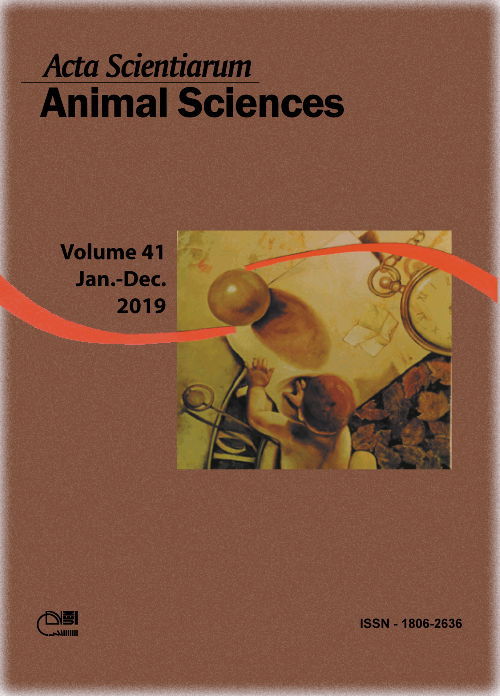The effect of vinasse on the growth performance and feed digestibility of Holstein male calves
Abstract
Industrial effluents of alcohol production are problematic for the environment. One of the proposed solutions to the reduction of harmful effects of the wastewater is to convert it into vinasse. The purpose of the present study is to investigate effects of rations with different levels of vinasse as a source of protein in the diet of 28 male Holstein calves, previously health checked, with an average initial weight of 300 ± 22.56 kg and the maximum similarity of weight and age. The calves were divided randomly into four treatments varied in vinasse (substituted for cottonseed meal): 0 (control), 5, 10 and 15 % with seven replications and each group was given its own specific diet for 110 days. Growth performance, nutrient digestibility and feed intake were examined. Final body weight, average daily weight gain and dry matter intake were significantly higher in calves fed diet with 10% vinasse compared to other treatments (p < 0.05). Rumen pH significantly increased in treatment four (15% vinasse) (p < 0.05). Crude fat, NDF, non-fiber carbohydrate (NFC) and dry matter digestibility didn’t show any significant difference between treatments (p > 0.05), but treatments with 10 and 15% vinasse significantly increased organic matter andcrude protein digestibility compared with control (p < 0.05). Totally substituting cottonseed meal with 10% vainasse in calves diet improved body weight gain and organic matter digestibility without any significant effects on rumen pH.
Downloads
References
Association Official Analytical Chemist [AOAC]. (2005). Official Methods of Analysis (18th ed.). Gaitherburg, MD: AOAC International.
Baile, C. A., & Forbes, J. M. (1974). Control of feed intake and regulation of energy balance in ruminants. Physiological Reviews, 54(1), 160-214. doi: 10.1152/physrev.1974.54.1.160.
Davis, L., Jeon, Y.-J., Svenson, C., Rogers, P., Pearce, J., & Peiris, P. (2005). Evaluation of wheat stillage for ethanol production by recombinant Zymomonas mobilis. Biomass and Bioenergy, 29(1), 49-59. doi: 10.1016/j.biombioe.2005.02.006.
Fernández, B., Bodas, R., López-Campos, Ó., Andrés, S., Mantecón, A. R., & Giráldez, F. J. (2009). Vinasse added to dried sugar beet pulp: Preference rate, voluntary intake, and digestive utilization in sheep. Journal of Animal Science, 87(6), 2055-2063. doi: 10.2527/jas.2008-1550.
Gallo, B. J., Gip Ospiua, P. H., & Santos, V. E. (2008). Preliminary evaluation of vinasse, a distillery by-products, as a possible source of nutrients in the poultry. Acta Agronomica, 36(2), 207-220.
Hammond, A. C. (1995). Leucaena toxicosis and its control in ruminants. Journal of Animal Science, 73(5), 1487-1492. doi: 10.2527/1995.7351487x.
Hannon, K., & Trenkle, A. (1990). Evaluation of condensed molasses fermentation solubles as a nonprotein nitrogen source for ruminants. Journal of Animal Science, 68(9), 2634-2641. doi: 10.2527/1990.6892634x.
Kemenade, P., den Hartog, L. A., Haaksma, J., & Verstegen, W. M. A. (1988). Beet vinasse in pig nutrition - Effect on digestibility and production. Mededeling. Instituut voor Rationele Suikerproduktie, 18, 52.
Kirchgessner, M., & Weigand, E. (1980). Broiler fattening trial with vinasse and molasses in the complete diet. Archiv fur Geflugelkunde, 44(3), 119-123.
Konan, V., Antolikova, M., & Husar, M. (1987). Use of di stillery by products for animal feeding. Agrochemia, 27, 219-221.
Leontowicz, H., Krzeminski, R., Leontowicz, M., Kulasek, G., Tropilo, J., & Sobczak, E. (1994). Condensed beet molasses solubles for fattening bulls. Journal of Animal and Feed Sciences, 3(1), 23-31. doi: 10.22358/jafs/69815/1994.
Lopez-Campos, O., Bodas, R., Prieto, N., Frutos, P., Andrés, S., & Giráldez, F. J. (2011). Vinasse added to the concentrate for fattening lambs: Intake, animal performance, and carcass and meat characteristics. Journal of Animal Science, 89(4), 1153-1162. doi: 10.2527/jas.2010-2977.
Maneerat, W., Prasanpanich, S., Tumwasorn, S., Laudadio, V., & Tufarelli, V. (2015). Evaluating agro-industrial by-products as dietary roughage source on growth performance of fattening steers. Saudi Journal of Biological Sciences, 22(5), 580-584. doi: 10.1016/j.sjbs.2015.01.015.
National Research Council [NRC]. (2001). Nutrient Requirements of Dairy Cattle (7th ed.). Washington, DC: Natlional Academy Press.
Potter, S. G., Moya, A., Henry, P. R., Palmer, A. Z., Becker, H. N., & Ammerman, C. B. (1985). Sugarcane condensed molasses solubles as a feed ingredient for finishing cattle. Journal of Animal Science, 60(3), 839-846. doi: 10.2527/jas1985.603839x.
Sampaio, A. V. P. D., Oliveira, M. D., Kronka, S. N., & Oliveira, D. (1989). Digestibility of rations containing different levels of dry vinasse of the nutrient digestibility in bovine feeding. Pesquisa Agropecuária Brasileira, 24(10), 1339-1342.
Statistical Analysis System [SAS]. (2004). SAS/STAT User guide, Version 9.1.2. Cary, NC: SAS Institute Inc.
Stemme, K., Gerdes, B., Harms, A., & Kamphues, J. (2005). Beet‐vinasse (condensed molasses solubles) as an ingredient in diets for cattle and pigs–nutritive value and limitations. Journal of Animal Physiology and Animal Nutrition, 89(3‐6), 179-183. doi: 10.1111/j.1439-0396.2005.00554.x.
Vadivel, R., Minhas, P. S., Kumar, S., Singh, Y., Nageshwar, R. D. V. K., & Nirmale, A. (2014). Significance of vinasses waste management in agriculture and environmental quality-Review. African Journal of Agricultural Research, 9(38), 2862-2873.
Van Keulen, J., & Young, B. A. (1977). Evaluation of Acid-Insoluble Ash as a Natural Marker in Ruminant Digestibility Studies. Journal of Animal Science, 44(2), 282-287.
Yalcin, S., Eltan, Ö., Karsli, M. A., & Yalcin, S. (2010). The nutritive value of modified dried vinasse (ProMass) and its effects on growth performance, carcass characteristics and some blood biochemical parameters in steers. Revue de Médecine Vétérinaire, 161, 245-252.
Zali, A., Eftekhari, M., Fatehi, F., & Ganjkhanlou, M. (2017). Effect of vinasse (condensed molasses solubles) on performance and meat chemical composition of Holstein male calves. Italian Journal of Animal Science, 16(3), 515-520. doi: 10.1080/1828051X.2017.1298407.
DECLARATION OF ORIGINALITY AND COPYRIGHTS
- I Declare that current article is original and has not been submitted for publication, in part or in whole, to any other national or international journal.
The copyrights belong exclusively to the authors. Published content is licensed under Creative Commons Attribution 4.0 (CC BY 4.0) guidelines, which allows sharing (copy and distribution of the material in any medium or format) and adaptation (remix, transform, and build upon the material) for any purpose, even commercially, under the terms of attribution.
Read this link for further information on how to use CC BY 4.0 properly.








































